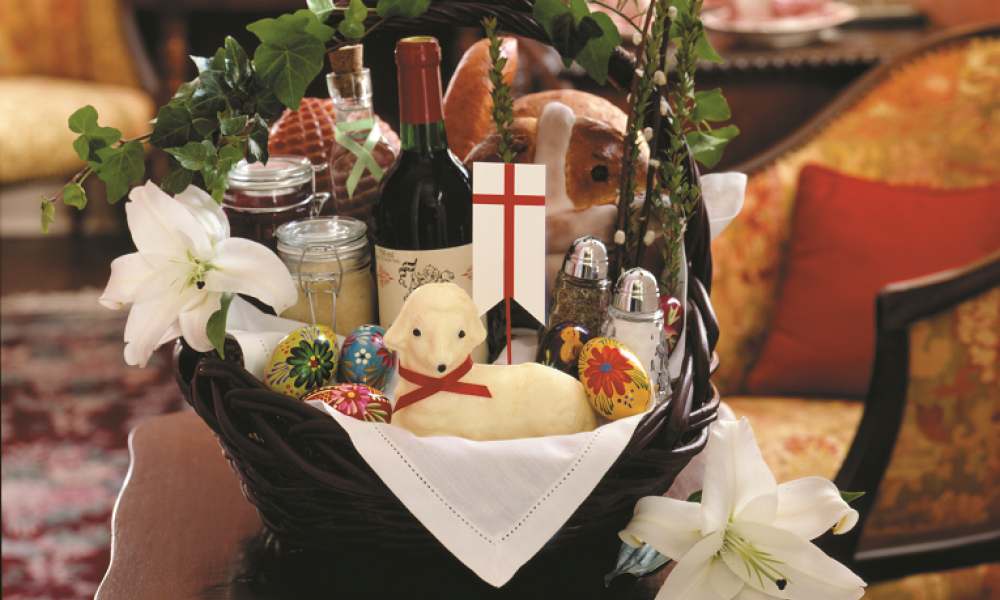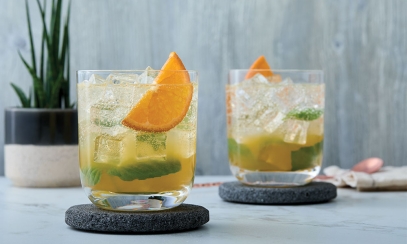
A Basket of Blessings
What is ham and kielbasa doing in an Easter basket?
Well, ham and kielbasa, along with other items such as vinegar, butter and salt and pepper, have been found in Easter baskets long before chocolate bunnies and cellophane grass became familiar basket fillers. Polish Catholics began the tradition of filling baskets with symbolic foods which are later served as part of the Easter meal.
“Traditions bring religion home,” says Canon Darius Wyszynski, Pastor of St. Stanislaus Kostka Parish in Jackson. “What is faith all about if it is not manifested?”
Swienconka, or the blessing of food baskets, is held in many Catholic Churches on Holy Saturday. (See page 23) Blessed foods are then to be the first eaten on Easter morning at breakfast – break fast – after the 40 days of Lenten sacrifice.
The first item you will need is a large wicker basket in which to place the following items:
The paschal lamb, the centerpiece of the symbolic foods. It is usually made of butter and molded into shape of the lamb, the sacrificial animal which came to symbolize Christ. The lamb is displayed with a victorious banner emblazoned by a cross – Christ victorious through His death.
Eggs, the symbol of life and resurrection. In fact, tradition calls for eggs to be the first food on Easter morning. Colored eggs, pisanki, represent Christ’s tomb. Originally, eggs were all dyed one color – red. Canon Wyszynski recalls his grandmother boiling beets in order to have a deep, rich red coloring on her eggs. The red, Canon Wyszynski says, symbolized “by His blood, we are cleansed."
Horseradish, vinegar and salt and pepper. Horseradish, as well as horseradish blended with beets, and pepper symbolize the bitter herbs of Passover and the Exodus, the bitter sufferings of Christ on the cross, and our sufferings found in the crosses that we bear throughout our lives. Vinegar is a reminder of the sour wine given to Jesus on the cross. Salt is a remembrance that we are all “salt of the earth.” (Mattthew 5:13)
Bread, the bread of life. Bread is broken at the table of Polish families after eggs with salt and pepper and horseradish have been shared. After each person has taken a piece of bread, with a sprinkle of salt, the full Easter meal is shared.
Ham and kielbasa. You don’t need a whole ham.
A few pieces are enough to symbolize that the Lord came to fulfill and exceed the Law. This means, in part, that forbidden dietary items of old, like pork, were made acceptable by Divine permission. Interestingly enough, the pig was an ancient symbol of prosperity.
Wine. A bottle of wine can be added to the contents of the basket in remembrance of the blood given up by Jesus on the cross.
Paska, a traditional Polish Easter sweet bread not only provides dessert for the Easter meal but symbolizes the bread of the Eucharistic.
Items that can also be placed in the basket are: other types of meats; cakes and pastries; and treats for the children. The basket itself is decorated with pussy willows, myrtle, greenery and branches – all joyful signs of new springtime life – as well as the new and eternal life won by Jesus. When palms were not available, the pussy willow would be used in Palm Sunday celebrations in Poland. Myrtle is a symbol of purity.
Add a little tradition to your Easter basket this year. Not only will it nourish your soul but it will also please your palate – more than a yellow marshmallow chick can any day.
Editor’s Note: Thanks are extended to Canon Darius Wyszynski and Wanda Palkowski in gathering items for the basket; Creative Baskets, Ann Arbor, styling; and New Palace Bakery in Hamtramck for the paska.
A cookie passion
Mix a Little Family Time with the Easter Story and Get Great Tasting Cookies, Too Most of us have a passion for cookies. Jesus' passion was for us. Here's a recipe to experience both.
Thanksgiving and Christmas are not the only holidays steeped in family traditions. Many parents, and grandparents alike, look forward to dying Easter eggs with the kids. This year we offer another tradition – one that combines family time while explaining the Easter story to youngsters. Don’t be surprised if you learn a thing or two about Jesus’ death and resurrection while you stir up these very special cookies!
To be made the evening before Easter
You will need:
1 c. whole pecans
1 tsp. vinegar
1 tsp. vanilla or almond extract
3 egg whites
A pinch of salt
1 c. sugar
Zippered baggie
Wooden spoon
Tape
Bible
Preheat oven to 300º F.
Place pecans in zippered baggie and let children beat them with the wooden spoon to break into small pieces. Explain that after Jesus was arrested, He was beaten by the Roman soldiers.
Read John 19:1-3.
Let each child smell the vinegar. Put 1 teaspoon vinegar into mixing bowl. Explain that when Jesus was thirsty on the cross, He was given vinegar to drink.
Read John 19:28-30.
Add egg whites to vinegar. Eggs represent life. Explain that Jesus gave His life to give us life.
Read John 10:10-11.
Sprinkle a little salt into each child’s hand. Let them taste it and brush the rest into the bowl. Explain that this represents the salty tears shed by Jesus’ followers, and the bitterness of our own sin.
Read Luke 23:27.
So far the ingredients are not very appetizing. Add 1 cup sugar and 1 teaspoon vanilla or almond extract. Explain that the sweetest part of the story is that Jesus died because He loves us. He wants us to know and belong to Him.
Read Psalm 34:8 and John 3:16.
Beat with a mixer on high speed for 12 to 15 minutes until stiff peaks are formed. Explain that the color white represents the purity in God’s eyes for those whose sins have been cleansed by Jesus’ death.
Read Isaiah 1:18 and John 3:1-3.
Fold in broken nuts. Drop by teaspoons onto a wax paper covered cookie sheet. Explain that each mound represents the rocky tomb where Jesus’ body was laid.
Read Matthew 27:57-60
Put the cookie sheet in the oven, close the door and turn the oven OFF. Give each child a piece of tape to seal the oven door. Explain that Jesus’ tomb was sealed.
Read Matthew 27:65-66.
GO TO BED! Explain that they may feel sad to leave the cookies in the oven overnight. Jesus’ followers were in despair when the tomb was sealed.
Read John 16:20 and 22.
On Easter morning, open the oven and give everyone a cookie. Notice the cracked surface and take a bite. The cookies are hollow! On the first Easter morning, Jesus’ followers were amazed to find the tomb open and empty.
Read Matthew 28:1-9.
Thanks to Jillane Job and her daughters, Ondrea and Whitney, for making the cookies.



